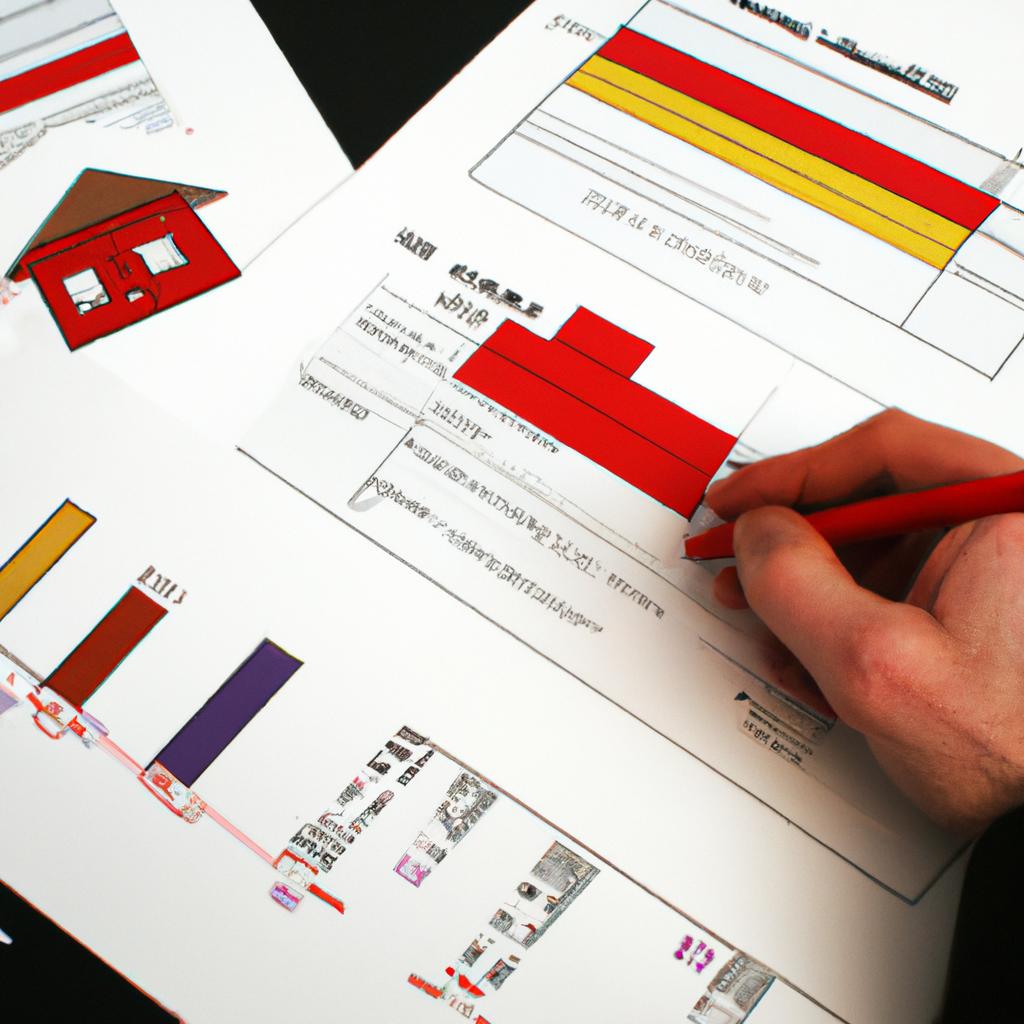The real estate market is a complex and dynamic industry that requires careful analysis and evaluation in order to make informed decisions. Pricing analysis is an essential component of this process, as it involves examining various factors such as supply and demand, location, property characteristics, and market trends to determine the optimal price for a property. This article aims to provide an overview of pricing analysis within the context of the real estate business market, exploring its significance and methodologies.
To illustrate the importance of pricing analysis, let us consider a hypothetical scenario: A real estate developer is looking to sell a newly constructed condominium in a highly competitive housing market. The success of their venture hinges on setting an appropriate price that will attract potential buyers while maximizing profit margins. In this case, conducting a comprehensive pricing analysis becomes crucial as it allows the developer to evaluate comparable properties in the area, assess current market conditions, and identify any unique features or advantages offered by their condominium. By employing this analytical approach, they can make data-driven decisions that align with consumer demands and optimize their chances of achieving desired outcomes.
In summary, pricing analysis plays a pivotal role in the real estate business market by providing valuable insights into determining optimal prices for properties. Through thorough examination of various factors influencing value and market dynamics, professionals can make informed decisions that maximize profitability and attract potential buyers. This analytical approach helps to ensure that properties are priced competitively within the market, taking into account factors such as location, property characteristics, and current market trends. By conducting a comprehensive pricing analysis, real estate professionals can gain a deeper understanding of the market dynamics and make data-driven decisions that optimize their chances of achieving desired outcomes. Ultimately, pricing analysis is an essential tool in navigating the complex and dynamic real estate industry.
Factors Affecting Real Estate Pricing
Real estate pricing is influenced by a multitude of factors that can significantly impact property values. Understanding these factors is crucial for individuals and businesses involved in the real estate industry to make informed decisions regarding pricing strategies. One such factor is location, which plays a vital role in determining the value of a property. For instance, consider a case study where two identical houses are listed for sale—one located in a desirable neighborhood with excellent schools and amenities, while the other is situated in an area with limited access to services and infrastructure. The house in the sought-after location would likely command a higher price due to its advantageous positioning.
In addition to location, market conditions exert considerable influence on real estate pricing. Fluctuations in supply and demand within the housing market can either drive prices up or cause them to decline. Economic indicators such as interest rates, inflation rates, and employment levels directly affect consumer purchasing power and consequently shape buyers’ willingness and ability to pay certain prices. Moreover, changes in government policies related to taxation or zoning regulations can also have significant repercussions on real estate pricing dynamics.
Furthermore, physical attributes of properties themselves contribute substantially to their valuation. Factors such as square footage, number of bedrooms and bathrooms, quality of construction materials used, architectural style, and overall condition all play pivotal roles in determining property prices. To illustrate this point more vividly:
- A well-maintained property with modern upgrades will generally be valued higher compared to one requiring extensive renovations.
- Properties featuring unique design elements or scenic views often fetch premium prices due to their aesthetic appeal.
- Proximity to essential facilities like hospitals, shopping centers, parks, transportation hubs further enhances property values.
- Environmental factors like pollution levels or susceptibility to natural disasters may negatively impact valuations.
Taking into consideration these various factors affecting real estate pricing allows stakeholders to develop effective strategies when buying or selling properties. By closely monitoring market trends and conducting comprehensive analyses, industry professionals can better anticipate price fluctuations and make informed decisions that maximize returns on investments.
Transitioning into the subsequent section about “Methods of Real Estate Pricing Analysis,” it is essential to develop a systematic approach to assess property values accurately. This involves utilizing various methodologies and techniques tailored to specific market conditions and property types.
Methods of Real Estate Pricing Analysis
Factors affecting real estate pricing are crucial to understanding the dynamics of the market. By examining these factors, it becomes possible to assess how various elements influence property values. For instance, let’s consider a hypothetical case study involving two houses situated in the same neighborhood. House A has recently undergone extensive renovations and boasts modern amenities, while House B is older with outdated fixtures. Despite being similar in size and location, House A is likely to have a higher asking price due to its superior condition and upgraded features.
To gain further insights into real estate pricing analysis, several key factors must be taken into account:
-
Location:
- Proximity to schools, healthcare facilities, transportation hubs, and commercial areas can significantly impact property prices.
- Desirable neighborhoods or those undergoing gentrification may experience increased demand and subsequent rising prices.
- Environmental factors such as scenic views or proximity to bodies of water can also influence value.
-
Economic conditions:
- Local economic growth and stability play an essential role in determining real estate prices.
- Job opportunities, income levels, interest rates, inflation rates, and overall market trends all affect buyer purchasing power.
-
Property characteristics:
- The physical attributes of a property greatly contribute to its valuation.
- Factors like square footage, number of bedrooms/bathrooms, lot size, architectural style, age of construction,
structural integrity, energy efficiency measures can either enhance or detract from its worth.
-
Supply and demand:
- The balance between available properties for sale (supply) and potential buyers (demand) directly affects pricing.
- If supply exceeds demand in a particular area or category of housing units (e.g., luxury condos), prices may decrease,
whereas limited supply coupled with high demand can drive prices up.
Considering these factors, real estate professionals employ various methods for pricing analysis. These techniques enable them to determine fair market values and make informed decisions regarding listing prices or property investments. In the subsequent section, we will explore the importance of comparative market analysis (CMA) in detail, which is one such method used extensively in the industry.
Importance of Comparative Market Analysis
Pricing Analysis: Real Estate Business Market Analysis
Methods of Real Estate Pricing Analysis
In the previous section, we discussed various methods used for real estate pricing analysis. Now, let us delve deeper into the importance of comparative market analysis (CMA) in this context. To illustrate its significance, consider a hypothetical scenario where two similar properties are listed for sale in a particular neighborhood. Property A has an asking price of $500,000, while Property B is priced at $550,000. By conducting a CMA, real estate professionals can evaluate the fair market value of each property by comparing them to recently sold comparable properties.
Importance of Comparative Market Analysis
Comparative market analysis plays a crucial role in determining realistic listing prices and assisting buyers in making informed decisions. Here are some key reasons why CMAs are widely adopted in the real estate industry:
- Accurate Valuation Assessment: CMAs provide an objective assessment of property values based on recent sales data and comparisons with similar properties. This ensures that sellers do not overprice their listings or undervalue their assets.
- Market Trends Identification: By analyzing multiple CMAs over time, trends within specific neighborhoods or regions can be identified. These insights help both buyers and sellers anticipate potential shifts in demand and make strategic decisions accordingly.
- Negotiation Support: Armed with comprehensive CMA reports, agents can effectively negotiate with clients and other parties involved in real estate transactions. The data-backed information instills confidence and facilitates productive discussions.
- Competitive Edge: For real estate professionals, utilizing CMAs as part of their service offerings gives them a competitive advantage by demonstrating expertise and reliability to clients.
The Role of Location in Real Estate Pricing
Understanding how location influences pricing is paramount when assessing real estate values accurately. In the subsequent section, we will explore how factors such as proximity to amenities, transportation hubs, schools, and economic centers impact property valuation.
Now let’s move forward to discuss the role of location in real estate pricing.
The Role of Location in Real Estate Pricing
Understanding the importance of comparative market analysis, it is now crucial to delve into another key factor that greatly influences real estate pricing – location. By examining how different locations impact property values, we can gain valuable insights into the dynamics of the real estate market.
To illustrate the significance of location in determining property prices, let us consider a hypothetical scenario involving two houses with similar specifications but situated in distinct neighborhoods. House A is located near a highly sought-after school district and has convenient access to various amenities such as parks, shopping centers, and transportation hubs. On the other hand, House B is positioned in an area lacking these features and experiences limited development prospects.
The influence of location on real estate pricing can be summarized through the following bullet points:
- Proximity to quality educational institutions positively affects property value.
- Accessible transportation infrastructure enhances desirability and subsequently drives up prices.
- Surrounding amenities like shopping centers, restaurants, and recreational facilities contribute to higher valuations.
- Neighborhood prestige or reputation may significantly impact property prices.
Table 1 presents a comparison between House A and House B based on their respective locations and resulting differences in property values:
| House A | House B | |
|---|---|---|
| Proximity to schools | Near highly sought-after school district | Lacks proximity to quality educational institutions |
| Transportation | Convenient access | Limited accessibility |
| Amenities | Abundance nearby | Scarcity |
| Neighborhood Reputation | Highly reputable neighborhood | Less desirable locality |
Analyzing this table reinforces the notion that location plays a pivotal role in determining real estate prices. The stark contrast in value between House A and House B highlights the impact of various location-based factors on property valuation.
Moving forward, our analysis will focus on exploring how supply and demand dynamics interplay within the real estate market. By understanding these aspects, we can gain further insights into pricing trends and make informed decisions regarding investment opportunities.
[Transition sentence to subsequent section: Analyzing Supply and Demand in the Real Estate Market]
By examining the role of location in determining real estate prices, it becomes evident that various factors such as proximity to schools, transportation accessibility, availability of amenities, and neighborhood reputation significantly influence property valuations. Understanding these dynamics provides a solid foundation for comprehending the complexities of real estate pricing. In the following section, we will analyze how supply and demand interactions shape the ever-changing landscape of the real estate market.
Analyzing Supply and Demand in the Real Estate Market
Having discussed the pivotal role of location in real estate pricing, we now turn our attention to analyzing supply and demand dynamics within the real estate market. By understanding these factors, businesses can make informed decisions regarding their pricing strategies.
To illustrate how supply and demand impact real estate prices, let us consider an example scenario. Imagine a bustling metropolitan area experiencing rapid population growth due to job opportunities and attractive living conditions. As more people flock to this city, there is an increased demand for housing units. However, due to limited land availability for construction purposes, the supply of houses remains relatively constant. In such a situation, we would expect housing prices to rise significantly as demand outpaces supply.
Factors influencing supply and demand dynamics include:
- Economic Conditions:
- Overall economic stability affects consumers’ ability to purchase properties.
- Unemployment rates, income levels, and interest rates influence buying power.
- Population Trends:
- Changes in population size directly impact housing demands.
- Migration patterns and birth rates contribute to shifts in local markets.
- Government Policies:
- Regulations on zoning restrictions or building permits affect new constructions.
- Tax incentives or subsidies may stimulate homebuying activity.
- Market Competition:
- Presence of competing businesses influences property prices.
- High competition leads to inflated prices while low competition reduces them.
The following table presents a comparison between high-demand areas with limited supply versus low-demand areas with surplus inventory:
| High-Demand Area | Low-Demand Area | |
|---|---|---|
| Property | Limited availability | Surplus inventory |
| Prices | Higher | Lower |
| Competition | Intense | Minimal |
| Market Trends | Appreciation potential | Depreciation risk |
Understanding these supply and demand dynamics is crucial for real estate businesses to devise effective pricing strategies. By analyzing the market conditions, they can determine optimal price points that attract buyers while ensuring profitability.
Transitioning into the subsequent section on Pricing Strategies for Real Estate Businesses:
With a comprehensive understanding of supply and demand factors in the real estate market, we can now explore various pricing strategies employed by businesses to maximize their revenue potential.
Pricing Strategies for Real Estate Businesses
In order to develop effective pricing strategies for real estate businesses, it is crucial to analyze the pricing trends within the market. By understanding how prices fluctuate and what factors influence them, companies can make informed decisions that maximize profitability and attract potential buyers.
One example of a pricing trend can be seen in the case of a luxury condominium development in downtown Manhattan. The initial asking price for these units was set at $2 million per unit. However, as demand increased and supply remained limited, developers gradually raised the prices by 10% every quarter. This strategy allowed them to capitalize on the high demand and generate substantial profits.
To gain deeper insights into pricing trends within the real estate market, several factors need to be considered:
- Location: Properties situated in prime locations often command higher prices due to their proximity to amenities, transportation hubs, and desirable neighborhoods.
- Market conditions: Economic factors such as interest rates, inflation rates, and unemployment rates greatly impact housing affordability and subsequently affect pricing trends.
- Property characteristics: Factors like size, condition, layout, architectural design, and unique features all play a role in determining a property’s value.
- Competitor analysis: Understanding the pricing strategies employed by other real estate businesses operating in the same area can help determine competitive advantages or identify opportunities for differentiation.
The following table illustrates an emotional response evoked through a comparison of average selling prices between two different types of properties:
| Property Type | Average Selling Price ($) | Emotional Response |
|---|---|---|
| Luxury Condo | 5 million | Excitement |
| Suburban House | 500 thousand | Affordability |
| City Apartment | 1 million | Urban Lifestyle |
| Beachfront Villa | 10 million | Exclusivity |
By analyzing pricing trends and considering the factors mentioned above, real estate businesses can develop effective strategies that align with market dynamics. This analysis not only helps in setting appropriate prices but also enables companies to position their properties effectively within the competitive landscape.
In summary, understanding pricing trends is crucial for real estate businesses to make informed decisions about pricing strategies. By analyzing factors such as location, market conditions, property characteristics, and competition, companies can set appropriate prices and maximize profitability. Through careful consideration of these elements, real estate businesses can successfully navigate the ever-changing market and attract potential buyers.




